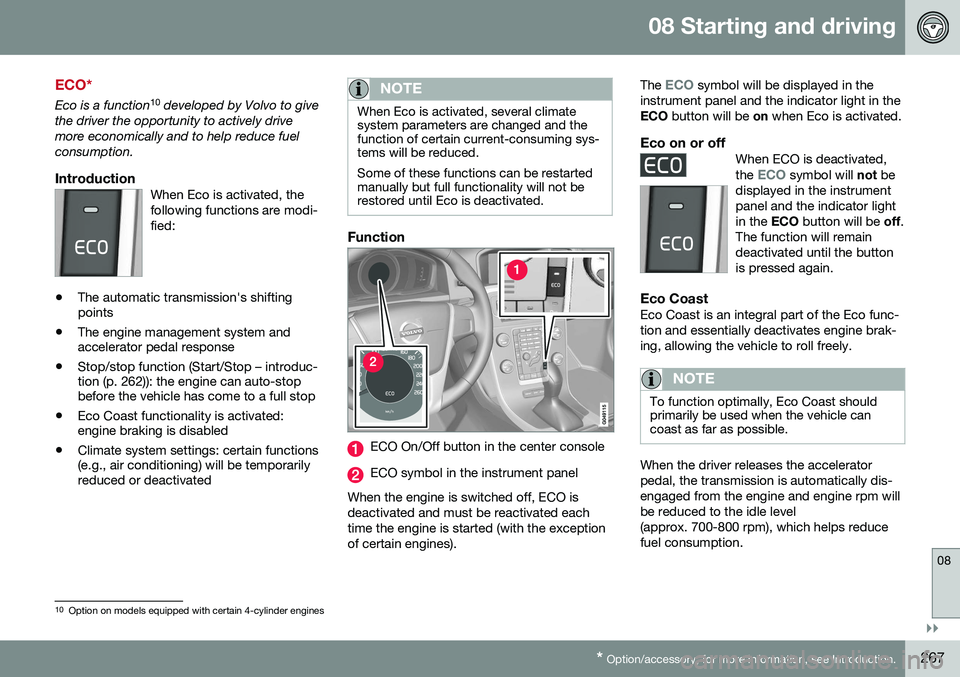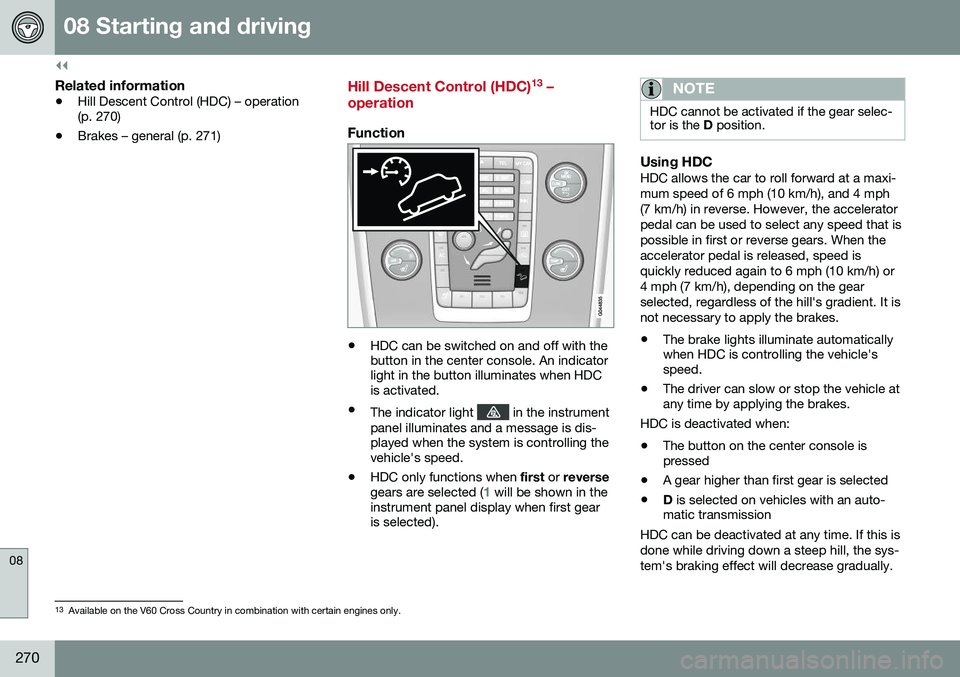2016 VOLVO V60 CROSS COUNTRY automatic transmission
[x] Cancel search: automatic transmissionPage 269 of 402

08 Starting and driving
08
}}
* Option/accessory, for more information, see Introduction.267
ECO*
Eco is a function 10
developed by Volvo to give
the driver the opportunity to actively drive more economically and to help reduce fuelconsumption.
IntroductionWhen Eco is activated, thefollowing functions are modi-fied:
• The automatic transmission's shifting points
• The engine management system andaccelerator pedal response
• Stop/stop function (Start/Stop – introduc-tion (p. 262)): the engine can auto-stopbefore the vehicle has come to a full stop
• Eco Coast functionality is activated:engine braking is disabled
• Climate system settings: certain functions(e.g., air conditioning) will be temporarilyreduced or deactivated
NOTE
When Eco is activated, several climate system parameters are changed and thefunction of certain current-consuming sys-tems will be reduced. Some of these functions can be restarted manually but full functionality will not berestored until Eco is deactivated.
Function
ECO On/Off button in the center console
ECO symbol in the instrument panel
When the engine is switched off, ECO is deactivated and must be reactivated eachtime the engine is started (with the exceptionof certain engines). The
ECO symbol will be displayed in the
instrument panel and the indicator light in the ECO button will be on when Eco is activated.
Eco on or offWhen ECO is deactivated, the ECO symbol will not be
displayed in the instrument panel and the indicator lightin the ECO button will be off.
The function will remaindeactivated until the buttonis pressed again.
Eco CoastEco Coast is an integral part of the Eco func- tion and essentially deactivates engine brak-ing, allowing the vehicle to roll freely.
NOTE
To function optimally, Eco Coast should primarily be used when the vehicle cancoast as far as possible.
When the driver releases the accelerator pedal, the transmission is automatically dis-engaged from the engine and engine rpm willbe reduced to the idle level(approx. 700-800 rpm), which helps reducefuel consumption.
10 Option on models equipped with certain 4-cylinder engines
Page 271 of 402

08 Starting and driving
08
}}
269
All Wheel Drive (AWD)
Your Volvo can be equipped with permanent All Wheel Drive, which means that power isdistributed automatically between the frontand rear wheels.
Under normal driving conditions, most of the engine's power is directed to the frontwheels. However, if there is any tendency forthe front wheels to spin, an electronicallycontrolled coupling distributes power to thewheels that have the best traction.
NOTE
The message AWD disabled Service
required will be appear in the information
display if an electrical fault should occur in the AWD system. A warning light will alsoilluminate in the instrument panel. If thisoccurs, have the system checked by atrained and qualified Volvo service techni-cian.
Related information
• Transmission – general information (p. 257)
Hill Descent Control (HDC) 11
–
introduction
HDC is a type of automatic engine brake and makes it possible to increase or decrease thevehicle's speed on downhill gradients usingonly the accelerator pedal, without applyingthe brakes. The brake system functions auto-matically to maintain a low and steady speed.
IntroductionNormally, when the accelerator pedal isreleased while driving down hills, the vehicle'sspeed slows as the engine runs at lower rpm(the normal engine braking effect). However, ifthe downhill gradient becomes steeper and ifthe vehicle is carrying a load, speed increasesdespite the engine braking effect. In this sit-uation, the brakes must be applied to reducethe vehicle's speed. HDC is particularly useful when driving down steep hills with rough surfaces, and where theroad may have slippery patches.
WARNING
HDC does not function in all situations, and is a supplementary braking aid. Thedriver has full responsibility for driving in asafe manner.
11 Available on the V60 Cross Country in combination with certain engines only.
Page 272 of 402

||
08 Starting and driving
08
270
Related information
•Hill Descent Control (HDC) – operation (p. 270)
• Brakes – general (p. 271)Hill Descent Control (HDC) 13
–
operation
Function
• HDC can be switched on and off with the button in the center console. An indicatorlight in the button illuminates when HDCis activated.
• The indicator light
in the instrument
panel illuminates and a message is dis- played when the system is controlling thevehicle's speed.
• HDC only functions when
first or reverse
gears are selected (
1 will be shown in the
instrument panel display when first gear is selected).
NOTE
HDC cannot be activated if the gear selec- tor is the D position.
Using HDCHDC allows the car to roll forward at a maxi- mum speed of 6 mph (10 km/h), and 4 mph(7 km/h) in reverse. However, the acceleratorpedal can be used to select any speed that ispossible in first or reverse gears. When theaccelerator pedal is released, speed isquickly reduced again to 6 mph (10 km/h) or4 mph (7 km/h), depending on the gearselected, regardless of the hill's gradient. It isnot necessary to apply the brakes.
• The brake lights illuminate automatically when HDC is controlling the vehicle'sspeed.
• The driver can slow or stop the vehicle atany time by applying the brakes.
HDC is deactivated when:
• The button on the center console ispressed
• A gear higher than first gear is selected
• D
is selected on vehicles with an auto-
matic transmission
HDC can be deactivated at any time. If this is done while driving down a steep hill, the sys-tem's braking effect will decrease gradually.
13 Available on the V60 Cross Country in combination with certain engines only.
Page 289 of 402

08 Starting and driving
08
}}
287
Towing a trailer
When towing a trailer, always observe the legal requirements of the state/province.
NOTE
For the maximum trailer and tongue weights recommended by Volvo, seeWeights (p. 378).
•All Volvo models are equipped with energy-absorbing shock-mounted bump-ers. Trailer hitch installation should notinterfere with the proper operation of thisbumper system.
Trailer towing does not normally present any particular problems, but take into considera-tion: • Increase tire pressure to recommended full pressure, see Tire inflation – pressuretable (p. 305).
• When your vehicle is new, avoid towingheavy trailers during the first 620 miles(1,000 km).
• Maximum speed when towing a trailer:50 mph (80 km/h).
• Engine and transmission are subject toincreased loads. Therefore, engine cool-ant temperature should be closelywatched when driving in hot climates orhilly terrain. Use a lower gear and turn offthe air conditioner if the temperaturegauge needle enters the red range. •
If the automatic transmission begins tooverheat, a message will be displayed inthe text window.
• Avoid overload and other abusive opera-tion.
• Hauling a trailer affects handling, durabil-ity, and economy.
• It is necessary to balance trailer brakeswith the towing vehicle brakes to providea safe stop (check and observe state/local regulations).
• Do not connect the trailer's brake systemdirectly to the vehicle's brake system.
• More frequent vehicle maintenance isrequired.
• Remove the ball holder when the hitch isnot being used.
NOTE
• When parking the vehicle with a trailer on a hill, apply the parking brakebefore putting the gear selector in
P.
Always follow the trailer manufactur-er's recommendations for wheelchocking.
• When starting on a hill, put the gearselector in
D before releasing the park-
ing brake.
• If you use the manual (Geartronic) shiftpositions while towing a trailer, makesure the gear you select does not puttoo much strain on the engine (usingtoo high a gear).
• The drawbar assembly/trailer hitchmay be rated for trailers heavier thanthe vehicle is designed to tow. Pleaseadhere to Volvo's recommended trailerweights.
• Avoid driving with a trailer on inclinesof more than 15%.
Page 392 of 402

12 Index
12
390
A
ABS (anti-lock brake system).................. 273
Accessory installation warning.................. 23
Active chassis system............................. 169
Active high beams..................................... 88Active yaw control........................... 169, 170
Adaptive brake lights............................... 273
Adaptive cruise control.................... 179, 180Airbags disconnecting the front passenger’s
side....................................................... 36
front...................................................... 33
inflatable curtain................................... 41
side impact........................................... 39
Air conditioning................................ 128, 129
Air distribution.................................. 124, 130
Air distribution table................................. 132
Air vents................................................... 124
Alarm........................................ 164, 165, 166
All Wheel Drive......................................... 269
Ambient temperature sensor..................... 75
Anti-freeze....................................... 280, 336Anti-lock brake system warning light......................................... 71
Anti-lock Brake System (ABS)................. 273 Approach lighting.............................. 96, 149
Auto-dim rearview mirror......................... 102
Automatic locking retractor....................... 47Automatic transmission
Eco (driving function).......................... 267
Geartronic........................................... 259
general description..................... 257, 259
oil........................................................ 382
shiftlock override................................ 261
Axle weight.............................................. 306
B
Battery maintenance............................... 351, 352
remote key, replacing......................... 154
replacing............................................. 352
specifications...................................... 384
start/stop............................................ 384
warning symbols................................. 350
Blind Spot Information System (BLIS)..... 245 Cross Traffic Alert (CTA)..................... 247
Booster cushion, integrated.......... 57, 59, 60
Booster cushions....................................... 54
Brake lights.............................................. 273 Brake system
ABS..................................................... 273
Brake pad inspection.......................... 271
checking fluid level............................. 337
emergency brake assistance.............. 274
fluid..................................................... 382
general information............................. 271
Hill Descent Control.................... 269, 270
Bulbs cargo area lighting.............................. 345
headlights... 339, 340, 341, 342, 343, 344
introduction......................................... 339
license plate lights.............................. 345
specifications...................................... 346
C
Camera, Park Assist................................ 241
Capacity weight....................................... 306Cargo area changing bulbs................................... 345
steel grid............................................. 143
Cargo area cover..................................... 143
Cargo area net......................................... 141
Cargo net................................................. 141
Catalytic converter................................... 285
Page 394 of 402

12 Index
12
392
Electronic oil level sensor........................ 335
Electronic stability control....................... 169Emergency locking retractor...................... 47
Emergency starting.................................. 256
Emergency towing................... 289, 290, 291
Emission inspection readiness................ 330Engine overheating........................................... 73
specifications...................................... 379
Start/Stop........... 262, 263, 264, 265, 266
starting................................................ 252
switching off............................... 254, 255
Engine compartment overview................ 333
Engine Drag Control (EDC)...................... 170
Engine oil................................................. 380 checking............................................. 334
low pressure warning light.................... 72
volumes.............................................. 381
Engine remote start (ERS)........................ 254
Environment............................................... 22
F
Federal Clean Air Act............................... 327 Flat tires repairing with tire sealing system....... 319 Floor mats
cleaning.............................................. 367
placing correctly................................. 252
Fluid specifications.......................... 382, 383
Fog lights................................................... 71 rear........................................................ 92
Four C (active chassis system)................ 169
Front airbags.............................................. 33 disconnecting passenger’s side airbag 36
Front park assist.............................. 232, 240
Front seats................................................. 78 heated................................................. 127
Fuel filler cap........................................... 284
Fuel filler door, opening................... 283, 284
Fuel level warning light.............................. 71
Fuel requirements............................ 281, 282
Fuel tank volume..................................... 383
Fuses....................................... 354, 355, 361
G
Garage door opener HomeLink ®
Wireless Control
System........................................ 106, 107
Gasoline requirements............................. 282
Gas tank volume...................................... 383 Gauges...................................................... 66
Geartronic................................................ 259
Geartronic automatic transmission.......... 259
Generator warning light............................. 73
Glossary of tire terminology..................... 307
Grocery bag holder.................................. 141
Gross vehicle weight............................... 306
H
Hazard warning flashers............................ 93 Headlights
Active Bending Lights........................... 90
active high beams................................. 88
changing bulbs... 340, 341, 342, 343, 344
daytime running lights.......................... 87
high/low beams.................................... 88
high beam flash.................................... 88
tunnel detection.................................... 90
Headlight washers..................................... 97
Head restraints, rear seat.................... 82, 83
Heated front seats................................... 127
Heated oxygen sensors........................... 285
Heated rear seats.................................... 127
Heated steering wheel............................... 86
Heated windshield........................... 102, 129